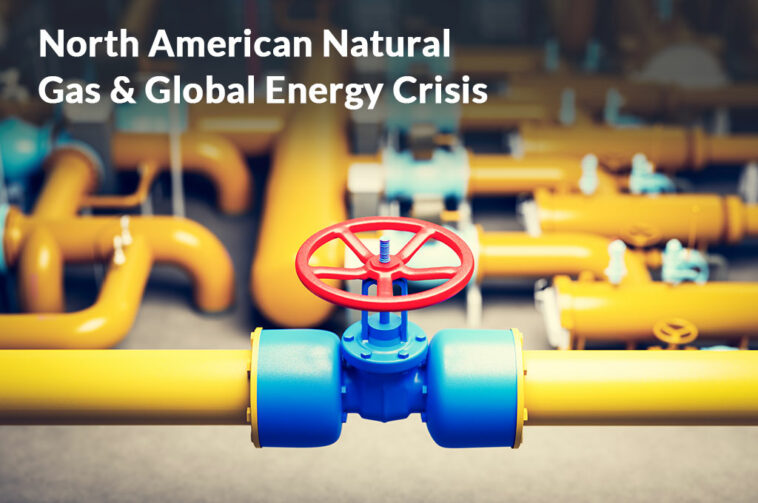North America (the United States and Canada) is endowed with significant natural gas resources that could play a vital role in addressing major challenges that the global energy industry faces today.
- North America could supply affordable energy to help counter high prices across the U.S. and Europe.
- The region could provide energy security by exporting liquefied natural gas (LNG) to Europe.
- Natural gas could replace high-emission forms of energy to help advance the decarbonization agenda.
North American countries have the potential to provide this low-cost, and alternative energy source. Greater collaboration across the industry, regulators and consumers could unlock this potential. Stakeholders could support reliable gas supply, develop North American gas infrastructure, and commit to long-term offtake agreements. These measures could reduce the prices of North American gas, and facilitate increased exports, thereby maintaining North American energy independence and providing energy security.
Challenge 1: Inflation and Affordable Energy
The gas prices in the United States and Europe increased substantially between July 2021 and July 2022. According to a report, US natural gas prices at Henry Hub rose more than 250%, and European gas prices increased by over 800% in the given time period.
Natural gas plays an important role in heating buildings, and power generation, and is used as a feedstock and energy source in industrial processes. Consequently, higher natural gas prices contribute to rising prices of glasses, plastics, cement, steel, and fertilizer. That leads to immediate cost increases in electricity production.
Challenge 2: Energy Security
Since February 2022, Russia’s invasion of Ukraine has had a profound human and socioeconomic impact across industries and countries. The reduced supply of Russian pipeline gas into the European Union (EU) has brought energy security to the fore. Consequently, European countries have slowed their coal-to-gas switching programs and, in some cases, reverted to using carbon-intense forms of energy such as lignite, and coal due to a lack of reliable and secure natural gas feedstock.
Europe is implementing measures to reduce dependency on Russian energy and strengthen energy security. Measures include:
- Delaying nuclear decommissioning
- Supporting energy-efficiency programs
- Accelerating renewables
- Building temporary and long-lasting infrastructure to import more LNG
As a result, an increase in Europe’s LNG exports could affect North American gas demand.
Challenge 3: The Carbon Budget
Both the United States and Europe face the dual challenge of providing a reliable energy supply while reducing emissions. According to a report, future emissions cannot exceed a carbon budget of 450 metric gigatons of CO2 equivalents (GtCO2e) from 2022 onwards to have a chance of limiting average global warming to 1.5 degrees Celsius. The world faces the immediate challenge of finding a solution to address climate change as quickly as possible while providing affordable and accessible energy to sustain lives and livelihoods.
Solutions – North American Natural Gas could Help Address These Challenges
North American natural gas resources could help overcome these challenges and provide affordable energy, address energy security, and offer a decarbonization level to help reduce carbon emissions.
Solution 1: Tackling Transportation to Reduce Prices
North America could meet over 30 years of domestic and LNG export demand, even when factoring in demand growth. On the demand side, there is a fluctuation in natural gas prices, while on the supply side, gas prices are steady & low. The fluctuations on the demand side are the result of transportation constraints, coupled with spikes in demand seasonality, and other market issues.
Solution 2: Reducing European Prices and Providing Energy Security
The United States and Canada are net energy exporters and have decreased reliance on other energy-producing through the discovery of large shale oil and gas resources. According to our data, the U.S. supplied crude oil worth USD 69 billion in 2021 and exported USD 26 billion worth of liquefied natural gas (LNG). Canada exported USD 81 billion worth of crude oil and USD 15 billion worth of gas last year. Let’s have a look at quarter-wise values of US and Canadian exports of oil and gas reported in 2022.

The United States has the fourth-largest natural gas resource in the world. Russia, Iran, and Qatar have the largest natural gas reserves. They have provided a secure and economical energy supply to domestic consumers and limited the impact of energy price shocks currently seen abroad. The U.S. and Canada could also provide a secure supply of natural gas to countries in the European and Asian continents through new LNG export facilities that could be developed within the next three years. North American LNG could help reduce natural gas and energy pricing in Europe.
Solution 3: Enabling Gas Infrastructure Development and Lowering Prices
The most prolific and lower-cost North American gas resources are in Appalachia and Western Canada, while the growing demand side, driven by industry and LNG export projects, is on the US Gulf Coast. Challenges around developing natural gas pipelines in North America have led to higher consumer prices. There are numerous large US natural gas pipelines in progress.
Affordable energy, European energy security, and staying within the global carbon budget are a few of the global energy industry’s toughest challenges. North America has ample natural gas reserves to help tackle these challenges.




